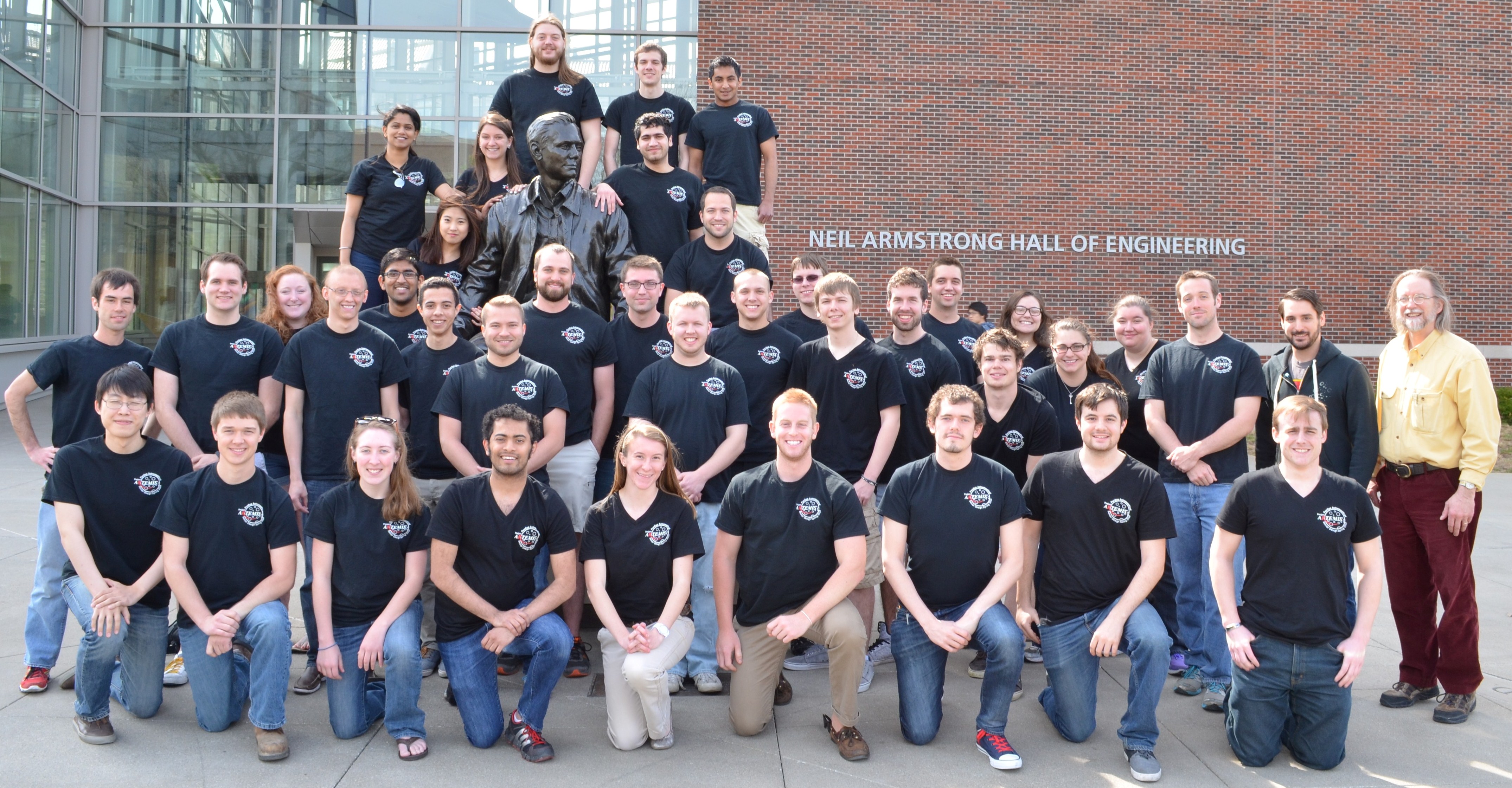AAE 450 Moon Colony: Project Artemis
| Event Date: | April 28, 2014 |
|---|
 Purdue students in Prof. James Longuski's AAE 450 class presented their Senior Design Moon Colony Proposal - Project Artemis to NASA Associate Administrator Bill Gerstenmaier, and other top NASA managers.
Purdue students in Prof. James Longuski's AAE 450 class presented their Senior Design Moon Colony Proposal - Project Artemis to NASA Associate Administrator Bill Gerstenmaier, and other top NASA managers.
The report and presentation is the culmination of an intensive spacecraft design course, AAE 450, undertaken by seniors during a single semester. The students perform a feasibility study for a specific mission goal, subject to certain constraints.
The goal of Project Artemis is to minimize the cost of establishing three human colonies on the Moon that, in a safe and timely manner, will ultimately enable a one-way-to-Mars mission. The colonies will be located at the Shackleton crater, the far side of the Moon, and at an entrance to a lunar lava tube. The colonists will live on the Moon for 42⁄7 years, which is equal to the two-synodic period of the cycler vehicle that will be used during the One-Way-to-Mars mission. The first colony on Mars will consist of eight people who will not see another human being until the second colony arrives, bringing the Mars colony up to 16 people. Colony cohesiveness and stability should improve as the size of the colony increases. The team were particularly interested in observing crew health (both mental and physical) while they live on the moon because little is known about how human physiology will fare on extended space missions.
The student team were able to give their presentation via a teleconference to the NASA Administrators. Following the presentation, Prof. James Longuski received feedback from Bill Gerstenmaier, who made the following comments:
"The video is impressive. As I watch videos, I imagine the time, engineering, and technology needed to make these things real. Things look easy in the video, but the engineering and work behind the video is immense and daunting. The 30 seconds of solar spiral to the moon is months to a year. This does not mean that we should not we should not dare to think big, but rather we use the videos as vision of the future. With videos and student projects like these, we can show that the 'boring' things we are doing today can enable an amazing future. Today, you can go to Michoud in New Orleans and touch SLS flight hardware that will fly in 2017. You can go to Kennedy Space Center and see an Orion crew capsule that will fly in December to test heat shield and avionics systems. Lastly, every day on ISS we are learning the skills necessary to make human journeys beyond low earth orbit a reality. We have been driving rovers on the Earth from ISS to demonstrate the ability to deploy antennas on the far side of moon from Orion or drive rovers to lava tubes as the video shows. We are building tools and techniques necessary for pioneering the solar system. This project allowed your AAE 450 student project team experience the engineering and work needed for space exploration and pioneering. Thanks for letting us see the talent and excitement of the next generation of space engineers.”
The presentation was covered in the Lafayette Journal and Courier and was headlined "Purdue Students Pitch Moon Colony Proposal to NASA". Following this publication, Purdue President Mitch Daniels contacted Prof. James Longuski and said: "I really enjoyed reading about the lunar colony project in today's paper. As it is directly relevant to many deep discussions we had on our National Academy study, which is now complete and in the review process. Please pass along to the students how interested I was in their work".
Project Artemis Team Members:
Project Manager: Andrew Cox
Assistant Project Manager: Parth Shah
Aerodynamics: Andrew James, Nick LaPiana (Team Leader), Cameron Horton
Communications: Ian Bennett (Team Leader), Eric Menke
Controls: Alana Tice, Spenser Guerin, Matt McDougall, Sadie Holbert (Team Leader), Ryan Allen
Human Factors: Ben Fishman, Alexis Turner, Taylor Schultz, Seung Soo Lee, Jessica Callinan (Team Leader), Hani Kim
Mission Design: Krista Garrett, Alex Van Anderlecht, Jose Miguel Blanco Iglesias, Michael Creech, Thomas Rich (Team Leader)
Power and Thermal: Andrew Powis (Team Leader), Michael Bilyeu, Vince Purdy, Walter Schostak, Trevor Satornino, Divinaa Burder, Joe Avellano
Propulsion: Bryan Foster, Finu Lukose (Team Leader), Sean Snoke, Eric Flores
Structures: Andrew Emans, Erik Slettehaugh, Arika Armstrong, Saagar Unadkat (Team Leader), Scott Sylvester
The AAE 450 Spacecraft Design Class website can be found here
The You Tube video which includes the 17 minute slide presentation and the 5-minute movie can be found here
The team would like to acknowledge the following to help and assistance:
Prof. David Filmer, for guidance and assistance with communication systems
Prof. Stephen Heister, for guidance and assistance with propulsion systems
Prof. Kathleen Howell, for guidance and assistance with orbit planning
Mr. Dayton L. Jones, for his guidance and assistance on the radio interferometer design and implementation
Prof. Karen Marais, for guidance and assistance with risk analysis
Prof. David Minton, for guidance and assistance with lunar geology and science payload selection
Mr. Sarag Saika, for his guidance and assistance in the guidance, navigation, and control of the communications satellites
Mr. John Steinmeyer, for his assistance in selecting a launch vehicle for small satellite launches
Dr. Boris Yendler, for guidance and assistance with power and thermal systems
Mr. Jeffrey Stuart, for his guidance and assistance in solving the three-body problem
Mr. James Waldie, for his insights about micro-gravity health concerns
Multi-Body Dynamics Research Group at Purdue for providing the Avizo software used in 3D Visualization
Special Thanks to:
Dr. James Longuski - Instructor
Mr. Frank Laipert - Teaching Assistant